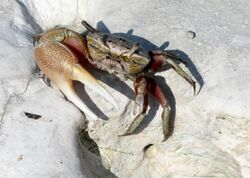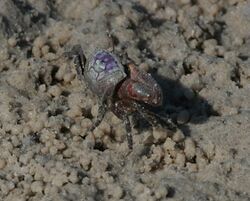Biology:Uca pugilator
| Uca pugilator | |
|---|---|

| |

| |
| Scientific classification | |
| Kingdom: | |
| Phylum: | |
| Subphylum: | |
| Class: | |
| Order: | |
| Infraorder: | |
| Family: | |
| Genus: | |
| Species: | U. pugilator
|
| Binomial name | |
| Uca pugilator (Bosc, 1802)
| |
Uca pugilator, the sand fiddler crab is a species of fiddler crab that is found from Massachusetts to the Gulf of Mexico. It lives in burrows in coastal and estuarine mud-flats, and can be extremely abundant. It can be differentiated from its congeners U. pugnax and U. minax by the smoothness of the inside of its claws. One claw is larger than the other, and can be much larger than the crab's body, at up to 41 mm (1.6 in) long.
Description
The carapace is square in shape, tapering slightly to the rear; it can reach a width of 25 millimetres (0.98 in), but is typically up to 21 mm (0.83 in) wide and 14 mm (0.55 in) long.[1] The space between the eyes is much shorter than the eyestalk. The males have one extremely enlarged chela (claw), which they use to claim their territory and fight with other males. The claw can be much larger than the body, at up to 35 mm (1.4 in) long, or exceptionally up to 41 mm (1.6 in) long.[1] It is common for males to lose claws in the battles. When this happens, the claw regenerates and the opposite side begins to enlarge. Fiddler crabs are right or left clawed. The inside of these claws are also very smooth, unlike its other close relatives Uca pugnax and Uca minax.[2]
Geographic distribution
Uca pugilator is one of only five species of fiddler crabs found primarily in temperate areas.[3] The species occurs on the east coast of North America and in the Gulf of Mexico, having been found as far north as Massachusetts and as far south as Texas and Florida. This species has also reportedly been found in the Bahamas.[4] They may also be found in the warmer waters of the Atlantic along the West coast of Africa.
Habitat
Uca pugilator can be found in estuarine and coastal areas or sheltered shores with sandy or muddy substrates.[3] It is frequently found in areas bordering marshes and along the banks of tidal streams.[4] It can be found in these areas in large numbers – thousands to millions.[3]
References
- ↑ 1.0 1.1 L. H. Sweat (August 17, 2009). "Uca pugilator, Atlantic Sand Fiddler Crab". Indian River Lagoon Species Inventory. Smithsonian Marine Station at Fort Pierce. http://www.sms.si.edu/irlspec/uca_pugila.htm. Retrieved September 11, 2012.
- ↑ Kenneth L. Gosner (1978). Petersons Field Guides: Atlantic Seashore. Houghton Mifflin. ISBN 978-0-395-31828-7. https://archive.org/details/fieldguidetoatla00kenn.
- ↑ 3.0 3.1 3.2 Jocelyn Crane (1975). Fiddler crabs of the world. Princeton, New Jersey: Princeton University Press. pp. 736. ISBN 978-0-691-08102-1. https://archive.org/details/fiddlercrabsofwo00cran.
- ↑ 4.0 4.1 Austin B. Williams (1984). Shrimps, lobsters, and crabs of the Atlantic coast of the eastern United States, Maine to Florida. Washington, D.C.: Smithsonian Institution Press. pp. 550. ISBN 0-87474-960-3.
Wikidata ☰ Q2723510 entry

